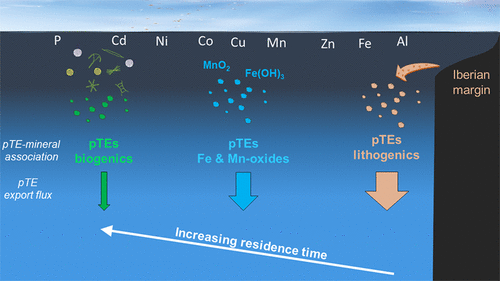当前位置:
X-MOL 学术
›
ACS Earth Space Chem.
›
论文详情
Our official English website, www.x-mol.net, welcomes your
feedback! (Note: you will need to create a separate account there.)
Particulate Trace Element Export in the North Atlantic (GEOTRACES GA01 Transect, GEOVIDE Cruise)
ACS Earth and Space Chemistry ( IF 2.9 ) Pub Date : 2020-10-27 , DOI: 10.1021/acsearthspacechem.0c00045 Nolwenn Lemaitre 1, 2, 3 , Hélène Planquette 2 , Frank Dehairs 3 , Frédéric Planchon 2 , Géraldine Sarthou 2 , Morgane Gallinari 2 , Stéphane Roig 2 , Catherine Jeandel 4 , Maxi Castrillejo 5
ACS Earth and Space Chemistry ( IF 2.9 ) Pub Date : 2020-10-27 , DOI: 10.1021/acsearthspacechem.0c00045 Nolwenn Lemaitre 1, 2, 3 , Hélène Planquette 2 , Frank Dehairs 3 , Frédéric Planchon 2 , Géraldine Sarthou 2 , Morgane Gallinari 2 , Stéphane Roig 2 , Catherine Jeandel 4 , Maxi Castrillejo 5
Affiliation

|
Vertical export of particulate trace elements (pTEs) is a critically underconstrained aspect of their biogeochemistry. Here, we combine elemental analyses on large (>53 μm) particles and 234Th measurements to determine downward export fluxes from the upper layers (40–110 m) of pTEs (Al, Cd, Co, Cu, Fe, Mn, Ni, P, Ti, V, Zn) and mineral phases (lithogenic, Fe- and Mn-oxides, calcium carbonate, and opal) in the North Atlantic along the GEOVIDE transect (Portugal–Greenland–Canada; GEOTRACES GA01 cruise). The role of lithogenic particles in controlling TE fluxes is obvious at proximity of the Iberian margin where the highest pTE export fluxes were estimated (up to 3912 μg/m2/d for pFe). However, high lithogenic and pTE fluxes are also observed up to 1700 km off this margin in the west European and Icelandic basins (up to 931 μg/m2/d for pFe). The lowest pTE export fluxes are determined in the Labrador Sea (as low as 501 μg/m2/d for pFe). High Mn- and Fe-oxide fluxes are estimated at the open ocean stations, suggesting that authigenic particles are an important vector of pTEs. All along the transect, biogenic particles also drive the pTE export fluxes, as shown by the similar pTE/POC ratios between exports and phytoplankton quotas. The shortest residence times (dissolved + particulate) are generally observed where lithogenic particles control the pTE fluxes (as low as 2 days for Fe) whereas pTEs seem to be longer retained when the contribution of biogenic particles become greater (residence times up to 147 days for Fe).
中文翻译:

北大西洋的微粒痕量元素出口(GEOTRACES GA01 Transect,GEOVIDE Cruise)
垂直输出颗粒痕量元素(pTEs)是其生物地球化学中受到严重限制的一个方面。在这里,我们结合了对大颗粒(> 53μm)和234 Th测量值的元素分析,以确定pTEs(Al,Cd,Co,Cu,Fe,Mn,Ni,沿GEOVIDE断面(葡萄牙-格陵兰-加拿大; GEOTRACES GA01航行)的北大西洋的P,Ti,V,Zn)和矿物相(成岩,铁和锰的氧化物,碳酸钙和蛋白石)。岩溶颗粒在控制TE通量中的作用在伊比利亚边缘附近很明显,那里估计有最高的pTE出口通量(高达3912μg/ m 2)/ d(对于pFe)。但是,在西欧和冰岛盆地距边界的距离达1700 km处也观察到了高岩性和pTE通量(pFe高达931μg/ m 2 / d)。最低的pTE出口通量是在拉布拉多海确定的(低至501μg/ m 2)/ d(对于pFe)。在远洋站估计有较高的Mn和Fe氧化物通量,这表明自生颗粒是pTE的重要载体。贯穿整个样带,生物颗粒也驱动pTE的出口通量,如出口和浮游植物配额之间类似的pTE / POC比值所示。通常观察到最短的停留时间(溶解+颗粒),其中生石颗粒控制pTE通量(Fe低至2天),而当生物颗粒的贡献更大时,pTE似乎保留更长时间(停留时间最多147天)铁)。
更新日期:2020-11-19
中文翻译:

北大西洋的微粒痕量元素出口(GEOTRACES GA01 Transect,GEOVIDE Cruise)
垂直输出颗粒痕量元素(pTEs)是其生物地球化学中受到严重限制的一个方面。在这里,我们结合了对大颗粒(> 53μm)和234 Th测量值的元素分析,以确定pTEs(Al,Cd,Co,Cu,Fe,Mn,Ni,沿GEOVIDE断面(葡萄牙-格陵兰-加拿大; GEOTRACES GA01航行)的北大西洋的P,Ti,V,Zn)和矿物相(成岩,铁和锰的氧化物,碳酸钙和蛋白石)。岩溶颗粒在控制TE通量中的作用在伊比利亚边缘附近很明显,那里估计有最高的pTE出口通量(高达3912μg/ m 2)/ d(对于pFe)。但是,在西欧和冰岛盆地距边界的距离达1700 km处也观察到了高岩性和pTE通量(pFe高达931μg/ m 2 / d)。最低的pTE出口通量是在拉布拉多海确定的(低至501μg/ m 2)/ d(对于pFe)。在远洋站估计有较高的Mn和Fe氧化物通量,这表明自生颗粒是pTE的重要载体。贯穿整个样带,生物颗粒也驱动pTE的出口通量,如出口和浮游植物配额之间类似的pTE / POC比值所示。通常观察到最短的停留时间(溶解+颗粒),其中生石颗粒控制pTE通量(Fe低至2天),而当生物颗粒的贡献更大时,pTE似乎保留更长时间(停留时间最多147天)铁)。











































 京公网安备 11010802027423号
京公网安备 11010802027423号